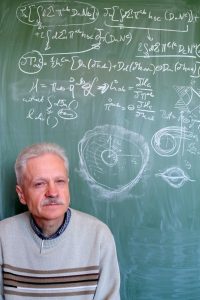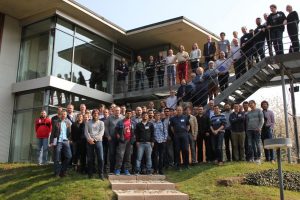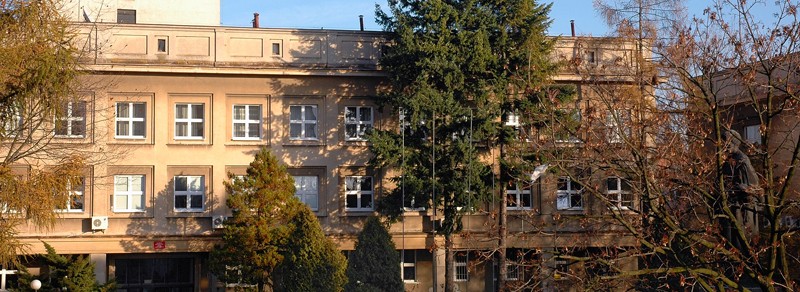Next seminar is scheduled on May 14, 2019 at 10.15 a.m., during which prof. dr hab. Tadeusz Domański will give his talk entitled „From Shiba states to topological superconductivity".
SEMINAR, May 7, 2019
Next seminar is scheduled on May 7, 2019 at 10.15 a.m., during which prof. Paweł Hawrylak (University of Ottawa) will give his talk entitled „Semiconductor and graphene quantum dots: laboratory for correlated electrons”.
New grant
Krzysztof Pomorski received a grant SHENG from National Science Centre for the project "Theoretical investigation of the low and middle energy nuclear fission". The investigations will performed in cooperation with Zhigang Xiao from Tsinghua University, China.
Congratulations!
Interview with Marek Rogatko
Interview with Marek Rogatko in local newspaper Dziennik Wschodni not only about first photography of a black hole.

FOT MACIEJ KACZANOWSKI / DZIENNIK WSCHODNI
Workshop Bound States in Superconductors and Interfaces in Dresden
The focused workshop Bound States in Superconductors and Interfaces took place from 8-th till 10-th April 2019, and hosted 66 participants from 20 different countries. Its main purpose was to exchange information on the current realizations, challenges and future perspectives of electronic bound states inside the superconductor energy gap at impurities, interfaces with superconducting reservoirs and various hybrid nanostructures. The associated quasiparticles are presently of considerable importance because they enable unique phenomena, such as e.g. long-lived qubits, evolution of discrete sub-gap states into topologically non-trivial bands hosting Majorana-type endmodes, and allow for experimentally controllable spectroscopy of correlated many-body states.
The workshop brought together the leading experts, both in experimental and theoretical studies in this field. The talks discussed realizations of the subgap states in various materials and devices, their detection in hybrid quantum dots and/or artificial quantum impurities embedded in the Josephson- and Andreev-type junctions, spectroscopy of the bound states in semiconducting nanowires, carbon nanotubes, hybrid superconductor-semiconductor quantum dots, gate-tunable studies of the subgap Kondo regime and many other related issues. Theoretical lectures have addressed the correlation effects, nonlocal processes, dynamic phenomena and properties of exotic mutations of the bound states in topological materials.
A comprehensive overview of the phenomena related to existence of defects/impurities in superconductors has been delivered by Alexander V. Balatsky (NORDITA), emphasizing the recently discovered Dirac materials and exotic types of electron pairing with an odd symmetry. His colloquium has been attended not only by participants of the workshop but also by members of the Max Planck Institute and other neighboring research institutions. Invited lectures have been given by internationally recognized experts of the experimental and theoretical studies. Several younger scientists have contributed their brief talks on important problems related to the bound states. During the first day of the workshop there has been organized a poster session with 30 presentations. Individual discussions between participants gave an opportunity to exchange ideas and might stimulate the ongoing and establish new collaboration projects, leading to development of this research field. Overall, the workshop provided a pleasant atmosphere with lively discussions.
Webpage address: https://www.pks.mpg.de/bossa19/

SEMINAR, April 9, 2019
Next seminar is scheduled on April 9, 2019 at 10.15 a.m., during which dr hab. Andrzej Staszczak will give his talk entitled „Do nuclei take the doughnut shape?”.
New publications in astrophysics
Numerical simulations of waveperiods of stochastically excited magnetoacoustic-gravity waves in a quiet region of the solar atmosphere
J. Kraśkiewicz, K. Murawski,
Monthly Notices of the Royal Astronomical Society 482, 3244 (2019)
https://doi.org/10.1093/mnras/sty2904
Cutoff periods of magnetoacoustic waves in the solar atmosphere
J. Kraśkiewicz, K. Murawski and Z. E. Musielak
Astronomy & Astrophysics, 623 (2019) A62
https://doi.org/10.1051/0004-6361/201833186
SEMINAR, March 26, 2019
Next seminar is scheduled on March 26, 2019 at 10.15 a.m., during which mgr Łukasz Baran (Faculty of Chemistry, UMCS) will give his talk entitled „Symulacje komputerowe samoorganizacji wybranych cząsteczek na powierzchniach ciał stałych”.
SEMINAR, March 12, 2019
Next seminar is scheduled on March 12, 2019 at 10.15 a.m., during which Prof. dr hab. Maciej Maśka (University of Silesia in Katowice) will give his talk entitled „Machine learning methods in physics”.
NASA presents the discovery made by our scientists
It is our pleasure to announce that the latest scientific discovery of pseudo-shocks in the solar atmosphere made by Prof. Krzysztof Murawski, Mr. Błażej Kuźma and Mr. Dariusz Wójcik from Theoretical Physics Division are presented in NASA web page.
More details can be found here:
